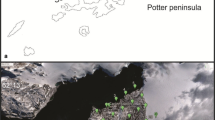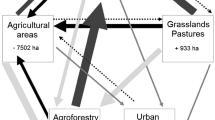Abstract
Epiphytic lichen vegetation was studied in 10 sites along an altitude gradient from 750 to 1510 m on NW-facing slopes of Mount Olympos, Greece to assess the main spatial heterogeneity of microhabitats affecting communities and species composition. Community structure along the gradient was studied by using multivariate techniques. The critical factor for spatial heterogeneity seems to be the height at which the lichen community develops on the tree trunks. Changes in the community structure of the epiphytic lichen vegetation were also detected along the altitudinal gradient and the altitude of 1200 m is considered to be an ecotone. A comparative study of epiphytic lichen communities on Mt. Olympos and in the Thessaloniki area revealed species indicators of air pollution.
Similar content being viewed by others
References
Barkman J. J. 1958. Phytosociology and ecology of cryptogamic epiphytes. Van Gorcum Co., Assen, Netherlands.
Brodo I. M. 1968. The lichens of Long Island, New York: A vegetational and floristic analysis. Bulletin New York State Museum and Science Service 410: 1–330.
Brodo I. M. 1973. Substrate Ecology. In: AhmadjianV. and HaleM. E. (eds), The Lichens. Academic Press, New York and London.
Culberson W. L. 1955a. The corticolous communities of lichens and bryophytes in the upland forests of northern Wisconsin. Ecol. Mon. 25: 215–231.
Culberson W. L. 1955b. Qualitative and quantitative studies on the distribution of corticolous bryophytes and lichens in Wisconsin. Lloydia 18: 25–36.
Diamantopoulos J., Pirintsos S., Laundon J. R. & Vokou D. 1992. The epiphytic lichens around Thessaloniki (Greece) as indicators of sulphur dioxide pollution. Lichenologist 24: 63–71.
Eversman S. 1982. Epiphytic lichens of a Ponderosa pine forest in Southeastern Montana. Bryologist 85: 204–213.
Eversman S., Johnson C. & Gustafson D. 1987. Vertical distribution of epiphytic lichens in three tree species in Yellowstone National Park. Bryologist 90: 212–216.
Hale M. E. 1955. Phytosociology of corticolous cryptogams in the upland forests of southern Wisconsin. Ecology 36: 45–63.
Hale M. E. 1952. Vertical distribution of cryptogams in a virgin forest in Wisconsin. Ecology 33: 398–406.
Harris G. P. 1971. The ecology of corticolous lichens. I. The zonation on oak and birch in South Devon. J. Ecol. 59: 431–439.
Hill M. O. & Gauch H. G. 1980. Detrended correspondence analysis, an improved ordination technique. Vegetatio 42: 47–58.
Hill M. O., Bunce R. G. H. & Shaw M. W. 1975. Indicator species analysis, a divisive polythetic method of classification, and its application to a survey of native pinewoods in Scotland. J. Ecol. 63: 597–613.
I.G.M.E. 1978–1983. Geological map of Greece. Institute of Geology and Mineral Exploration.
James P. W., Hawksworth D. L. & RoseF. 1977. Lichen communities in the British Isles: a preliminary conspectus. In: SeawardM. R. D. (ed), Lichen ecology. Academic Press, London, New York & San Francisco.
Kalgutkar R. M. & Bird C. D. 1969. Lichens found on Larix lyalii and Pinus albicaulis in southwestern Alberta, Canada Can. J. Bot. 47: 627–648.
Levins R. 1975. Evolution in changing environments: some theoretical explorations. In: WhittakerR. H. & LevinS. A. (eds), Niche Theory and Application. Dowden, Hutchinson & Ross, Inc., Stroudsburg, Pennsylvania.
Malloch A. J. C. 1988. VESPAN II A computer package to handle and analyse multivariate species data and handle and display species distribution data. University of Lancaster, Lancaster.
May R. M. 1976. Patterns in multi-species communities. In: MayR. M. (ed), Theoretical Ecology: principles and applications. Blackwell scientific publications, Oxford, London, Edinburgh, Boston, Melbourne.
Nimis P. L., Castello M. & Perotti M. 1990. Lichens as biomonitors of sulphur dioxide pollution in La Spezia (northern Italy). Lichenologist 22: 333–344.
Nimis P. L., Lazzarin A., Lazzarin G. & Gasparo D. 1991. Lichens as bioindicators of air pollution by SO2 in the Veneto region (NE Italy). Studia Geobot. 11: 3–76.
Pirintsos, S. A., Vokou, D., Diamantopoulos, J. & Galloway, D. J. 1993. An assessment of the sampling procedure for estimating air pollution using epiphytic lichens as indicators. Lichenologist (in press).
Pirintsos, S. A. & Diamantopoulos, J. 1991. Monitoring of air pollution in the area around of Thessaloniki. Proceedings of the second international conference on environmental pollution. Thessaloniki.
Rejmanek, M. 1979. Stability and complexity in biotic communities: Theoretical and empirical approach. V. Medzinarodne sympozium o problematike ekologickeho vyskumu krajiny, 19, CSSR.
Strid A. 1980. Wild Flowers of Mount Olympus. Goulandris Natural History Museum. Athens.
Author information
Authors and Affiliations
Rights and permissions
About this article
Cite this article
Pirintsos, S.A., Diamantopoulos, J. & Stamou, G.P. Analysis of the vertical distribution of epiphytic lichens on Pinus nigra (Mount Olympos, Greece) along an altitudinal gradient. Vegetatio 109, 63–70 (1993). https://doi.org/10.1007/BF00149545
Accepted:
Issue Date:
DOI: https://doi.org/10.1007/BF00149545




